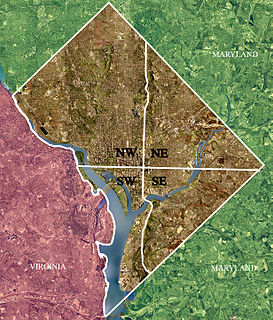
Northeast is the northeastern quadrant of Washington, D.C., the capital of the United States. It encompasses the area located north of East Capitol Street and east of North Capitol Street.
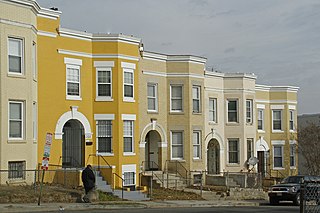
Eckington is a neighborhood in Northeast Washington, D.C., located south of the Prospect Hill and Glenwood Cemeteries. Eckington is less than one mile (1.6 km) southeast of Howard University and exactly one mile north of the United States Capitol. Eckington is also the home of the District of Columbia office of Sirius XM Radio.
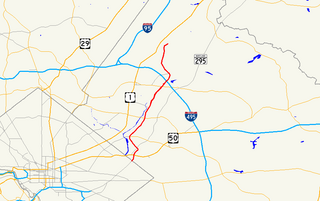
Maryland Route 201 is a state highway in the U.S. state of Maryland. Known for most of its length as Kenilworth Avenue, the highway runs 9.40 miles (15.13 km) from the District of Columbia boundary in Tuxedo, where the highway continues south as District of Columbia Route 295, north to MD 212 in Beltsville. MD 201 is a four to six-lane divided highway that connects Washington with the northern Prince George's County municipalities of Cheverly, Bladensburg, Edmonston, Riverdale Park, College Park, Berwyn Heights, and Greenbelt. The highway also provides part of the connections from Interstate 95 (I-95)/I-495 to a pair of Washington Metro stations. MD 201 was built as two separate highways in the late 1920s: MD 201 from Washington to Bladensburg and MD 205 from Bladensburg to Greenbelt. These highways, some of which became MD 769, were replaced with a relocated Kenilworth Avenue in the mid 1950s, including the Kenilworth Interchange with U.S. Route 50 and the Baltimore–Washington Parkway in Tuxedo. MD 201 was extended north to Beltsville in the early 1960s. The Maryland State Highway Administration (MDSHA) plans to extend MD 201 north toward Laurel.

New York Avenue is a diagonal avenue radiating northeast from the White House in Washington, D.C. to the border with Maryland. It is a major east–west route in the city's Northwest and Northeast quadrants and connects downtown with points east and north of the city via Cheverly, Maryland, the John Hanson Highway, the Baltimore–Washington Parkway, and eventually, Interstate 95.
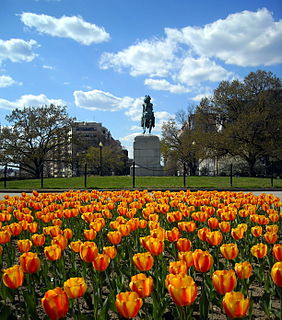
Washington Circle is a traffic circle in the northwest quadrant of Washington, D.C., United States. It is located on the border of the Foggy Bottom and West End neighborhoods, which is a part of the Ward 2 section in Washington. It is the intersection of 23rd Street, K Street, New Hampshire Avenue, and Pennsylvania Avenue, N.W. It borders many buildings of the George Washington University campus. The through lanes of K Street travel underneath the circle in a tunnel, while the service lanes intersect the circle.

Florida Avenue is a major street in Washington, D.C. It was originally named Boundary Street, because it formed the northern boundary of the Federal City under the 1791 L'Enfant Plan. With the growth of the city beyond its original borders, Boundary Street was renamed Florida Avenue in 1890.

Lincoln Park is the largest urban park located in the Capitol Hill neighborhood of Washington, D.C. It was known historically as Lincoln Square. From 1862 to 1865, it was the site of the largest hospital in Washington, DC: Lincoln Hospital.

During the American Civil War (1861–1865), Washington, D.C., the capital city of the United States, was the center of the Union war effort, which rapidly turned it from a small city into a major capital with full civic infrastructure and strong defenses.

The city of Winchester, Virginia, and the surrounding area, were the site of numerous battles during the American Civil War, as contending armies strove to control the lower Shenandoah Valley. Winchester changed hands more often than any other Confederate city.

Maryland Route 769 is a collection of unsigned state highways in the U.S. state of Maryland. These three highways are sections of old alignment of MD 201 and the former MD 205 in Bladensburg. MD 769D and MD 769C form the old alignment of MD 201 between a dead end next to the Baltimore–Washington Parkway and MD 450. MD 769B forms part of the old alignment of MD 205 in Bladensburg and Edmonston. The portions of MD 201 and MD 205 that are now part of MD 769 were constructed in the mid- to late 1920s and widened in the early 1940s. Modern MD 201 was constructed in the early to mid-1950s; many of the bypassed sections later became portions of MD 769.

The Department of the Gulf was a command of the United States Army in the nineteenth and early twentieth centuries and of the Confederate States Army during the Civil War.
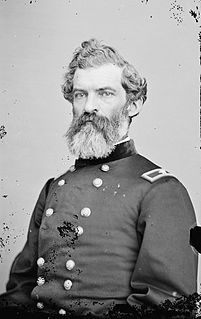
John Wilson Sprague was an American soldier and railroad executive. He served as a general in the Union Army in the Western Theater of operations during the American Civil War. He received the Medal of Honor for gallantry at the Battle of Decatur during the Atlanta Campaign. After the war, he was a railroad executive and later co-founded the city of Tacoma, Washington, serving as its first mayor.

The District of Oregon was a Union Army command department formed during the American Civil War.

Drum-Taps, first published in 1865, is a collection of poetry written by American poet Walt Whitman during the American Civil War.
Department of Washington, was a department of the Union Army constituted on April 9, 1861. It consisted of the District of Columbia to its original boundaries, and the State of Maryland as far as Bladensburg. It was merged into the Military Division of the Potomac on July 25, 1861. Later it was recreated on February 2, 1863 as the consolidated Department of Washington and XXII Corps. It was again made the Department of Washington in 1865 and that command remained until 1869 when it was disbanded.

The Armory Square Hospital formally known as the District Armory or Armory of the District of Columbia was a military hospital for the Union Army located on the National Mall in Washington, D.C., which operated from 1862 to 1865. It stood at the intersection of 6th Street SW and B Street SW between the Smithsonian Castle and the Capitol. The 12 wards extended across the Mall, all the way to the Canal. Today, the National Air and Space Museum stands in its place.

Harewood General Hospital was one of several purpose-built pavilion style hospitals operating in the Washington, D.C., area during the Civil War which rendered care to Union military personnel. A purpose-built pavilion style hospital, it was in use from September 4, 1862, to May 5, 1866.

Mount Pleasant General Hospital was a Union Civil War hospital in northwest Washington, D.C., which operated from March 28, 1862, to August 10, 1865.

Campbell General Hospital was a Union Civil War hospital which operated from September 1862 to July 20, 1865, in northwest Washington, D.C.

The Starburst Intersection refers to the intersection of six streets in northeast Washington, D.C.: Bladensburg Road NE (part of U.S. Route 1 Alternate, Benning Road NE, 15th Street NE, Maryland Avenue NE, and H Street NE intersect directly, and to the immediate northwest of this intersection is the easternmost point of Florida Avenue. The name "starburst" refers to the star-like shape created by these roads when viewed on a map.


























